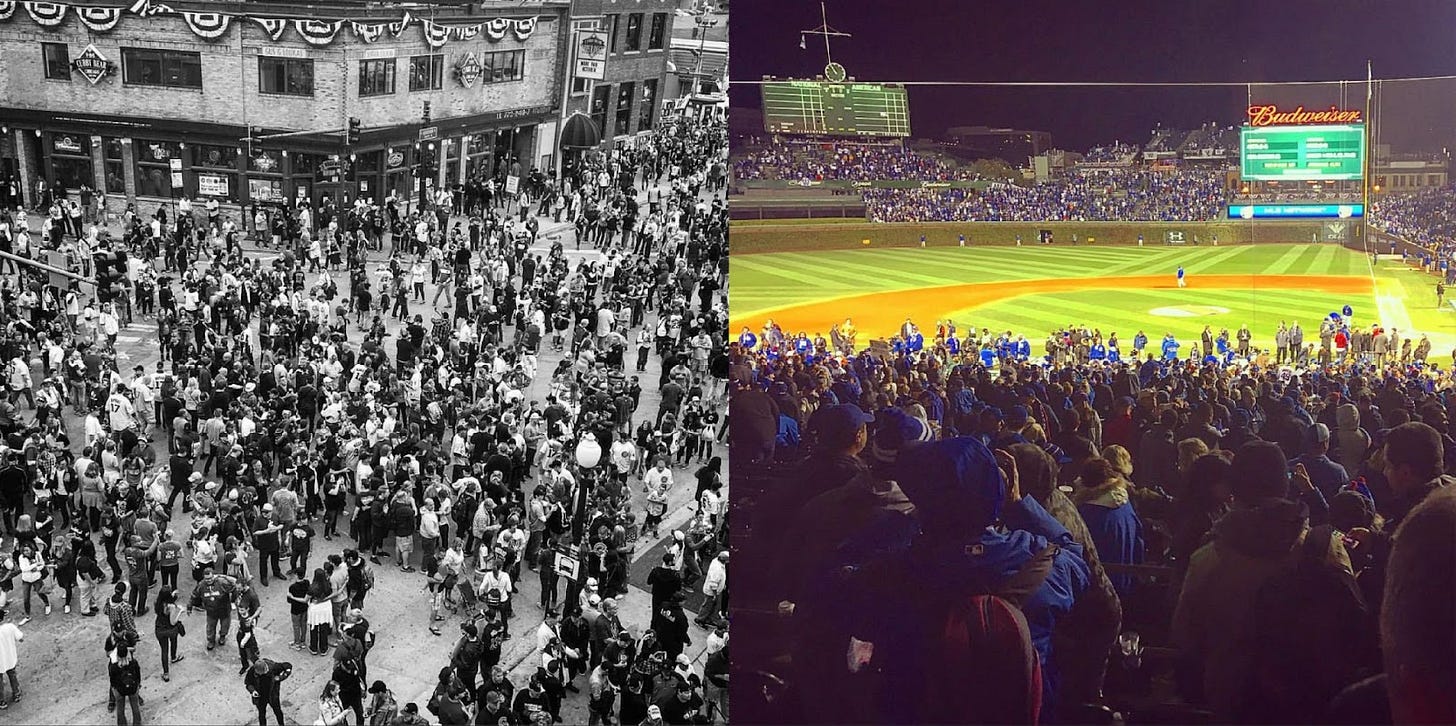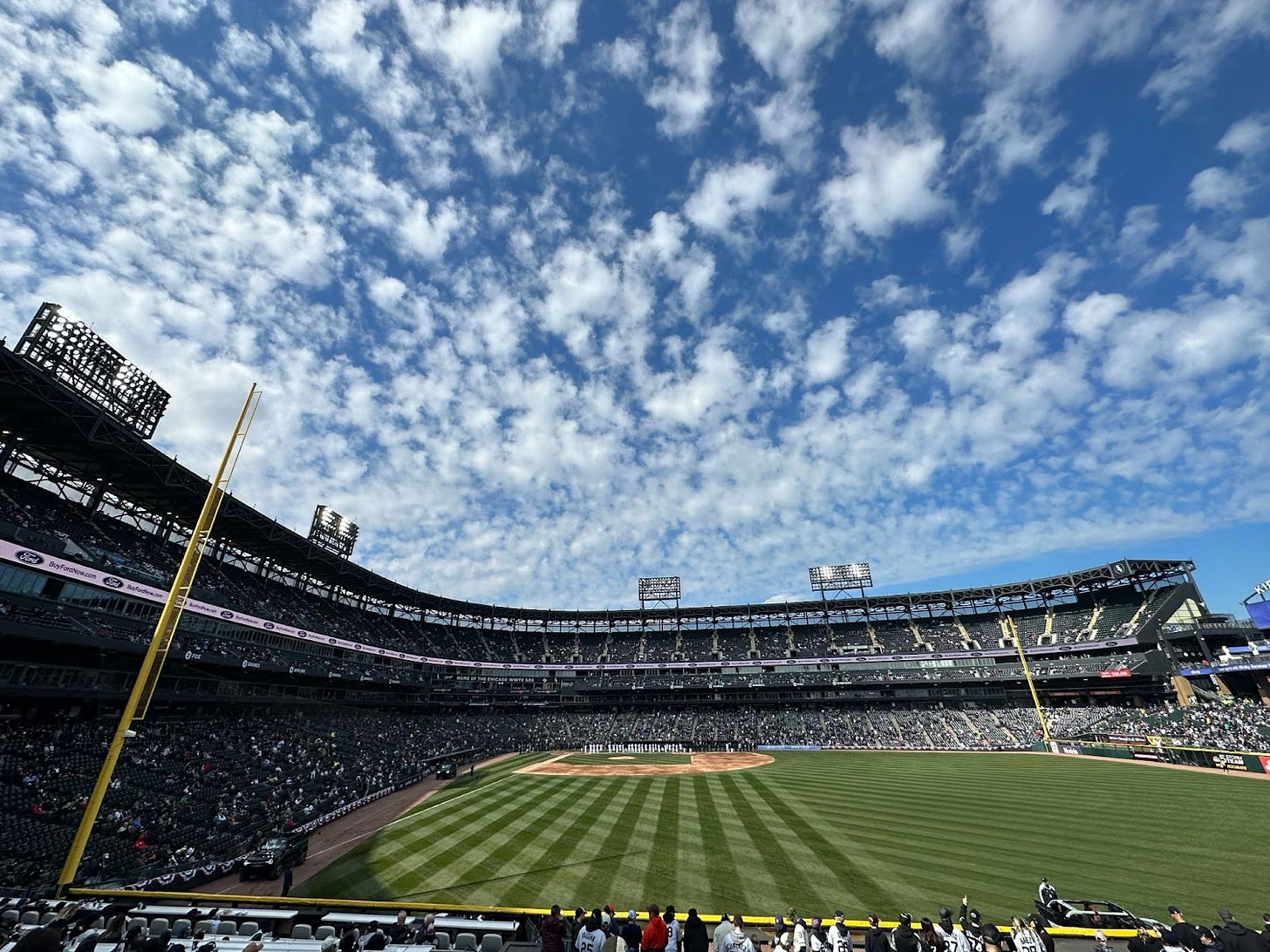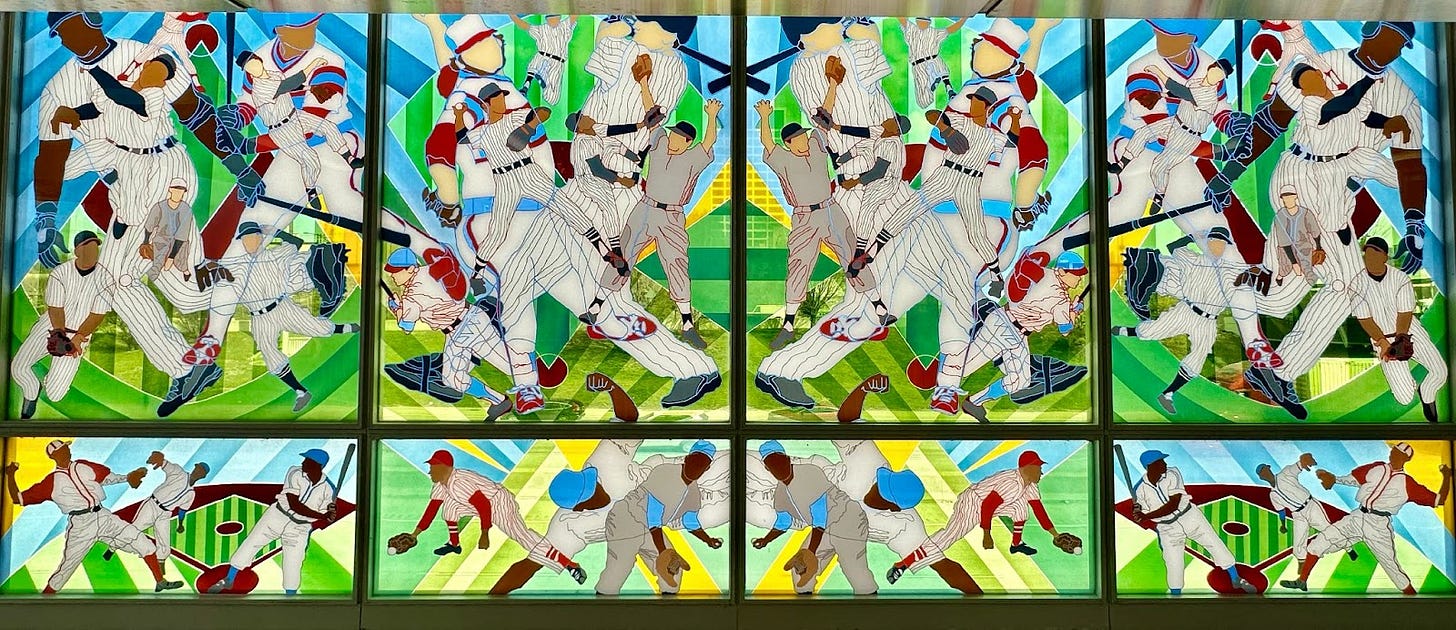The Malört You Know
A visit to Chicago, where the baseball is as good as the booze, for better and for worse
As I’m writing about a trip to Chicago, Chrystal and Colleen are podcasting about a Jewish catcher from New York on Dugout of History. I never made the majors or the spy services, but they are among the friends mentioned in the piece I’ve written, of course, and I’m so happy to produce their show and have it in this space. We’re gonna get back to posting here — I’m gonna get back to posting here — but not activate the paid subscriptions just yet. Instead, we’ll ask you to shop at casualdiehard.com, and get 10% off any order with the code NEWSLETTER. You’ll be supporting more of our creative efforts on the fashion side, and also relieving the pressure of needing to create a specific amount of content on a schedule because people are paying for it. Also, I want to be able to share pieces like today’s, not keep them behind a paywall.
So, please enjoy Chrystal and Colleen’s latest pod, and my latest writing! —Jesse
I haven’t been to Wrigley Field since Game 5 of the 2016 World Series, and I wasn’t planning to see the Friendly Confines on a trip to see the White Sox open the 2024 season. It was the next day, on the way to the airport, that my friend drove up Clark Street, and a red light at Addison happened to stop us at the historic intersection. Wrigley was always quaint but imposing.
This was the first time that it felt small. The biggest change happened in 2018 with the opening of an ultra-modern sore thumb of a hotel that dwarfs Wrigley, as well as the commercial complex past the ballpark on Clark. The candy red marquee remains prominent, but not dominant. The new sportsbook, built of bars of ivy-green metal, isn’t as repugnant aesthetically as ethically.
Repugnant does have its place in Cubs history, such as April 29, 1983, when manager Lee Elia put the majority of George Carlin’s heavy seven into a rant against the 9,931 fans who bothered to show up.
“They’re really, really behind you around here – my fuckin’ ass,” Elia said. “What the fuck am I supposed to do, go out there and let my fuckin’ players get destroyed every day and be quiet about it? For the fuckin’ nickel-dime people who turn up? The motherfuckers don’t even work! That’s why they’re out at the fuckin’ game. They oughta go out and get a fuckin’ job and find out what it’s like to go out and earn a fuckin’ living. Eighty-five percent of the fuckin’ world is working. The other fifteen come out here, a fucking playground for the cocksuckers.”
The next day, they got 26,069 at Wrigley, a combination of the calendar turning to Saturday and Fernando Valenzuela pitching for the Dodgers. It was the beginning of a historic attendance surge.
The Cubs’ attendance record is 3.3 million, in 2008. It was only 10 years before that when Sammy Sosa hit 66 homers and the Cubs drew a then-record 2.6 million – and 10 years before that when Wrigley got lights and could host night games. We’re now marking 41 years since Elia’s tirade, and more than 60% of the all-time attendance at Wrigley has come in the years since.
A combination of things happened after Elia got fired (somehow several months after going full Ron Burgundy on the city of Chicago). The Cubs got good and won the National League East, the song “Go, Cubs, Go” was released and started playing on WGN broadcasts, imploring everyone, “So come on down to Wrigley Field!” They did. Cubs attendance in 1984 was 2,107,655 – a jump of more than 5,000 fans per game over the previous record set in 1969.
The Cubs averaged 18,268 fans in 1983, and 34,261 in 2023. The explosion of Wrigleyville bars was a pure reaction to this – businesses going where the customers are. The Cubs would like to make that argument about the hotel, but on that ground once stood a McDonald’s, a business that is the antithesis of $6.49 hot dogs across the street.
From O’Hare, I was flying to Boston, retracing the steps of my first Chicago visit, part of a four-city baseball sprint, 20 years ago. There’s a ballpark-adjacent McDonald’s there, too, right outside the Kenmore T stop. If you take the D train to Yankee Stadium, and come up from a certain exit of 161 Street station, the first thing you’ll see is the Golden Arches. It’s not a necessity that a ballpark be McDonald’s adjacent, but the presence of a McDonald’s shows that not only is a place well-traveled, but that you don’t have to be rich to enjoy that place.
We turned left onto Addison, and just as quickly as I’d winced at the sight of the new construction, we might as well have been back on my first Chicago trip in 2004, or my last one in 2016. A church, a gym, a dry cleaner, a pizza joint… The only hint of the ballpark being a few blocks behind is a series of signs for the Cubs’ remote parking lots. That the neighborhood has had such staying power is incredible considering that more than half of its Cub-cheering visitors have come just in the years since Wrigley added lights.
In 2004, my first stop was also Wrigleyville, but only to drop off my bag, and buy a bedsheet and marker to bring to the South Side. The Expos and Marlins were playing there because of Hurricane Ivan, and I made a sign for my unironic favorite player whom I’d started following as a callup with one of my favorite teams ever, the 2002 Expos, Jamey Carroll.
I was part of the crowd of 5,457 that paid $5 a ticket to support storm relief efforts and see Florida beat Montreal, 8-6. I drove to Milwaukee to watch Barry Bonds that night, then back to Chicago for a pair of Sammy Sosa homers in my first game at Wrigley.
I kept coming back. When I’d go to Chicago as a hockey writer during the playoffs, I would check to see if the Cubs were home and squeeze in a game. When they shifted me from hockey to baseball at The Sporting News, the Cubs hit their peak and I found myself at Wrigley for work semi-regularly. They won the World Series, I got caught up in a round of layoffs the week after that happened, and I didn’t get back to Illinois for nearly a decade. My return visit was for opening day with the White Sox and pals from Casual Diehard’s podcasts.
I’m not going to deny the magic of a full stadium living and dying with every pitch in a no-hit bid or a playoff situation, but my ideal baseball experience is well shy of a sellout crowd. You get some breathing room in your section, shorter lines for hot dogs, and the ability to hold a conversation with someone because it’s not basketball or hockey with constant action, or football with hundred-percent intensity on each play.
That laser focus works in the playoffs, when every pitch could change everything, but through the spring and summer, so much of baseball’s appeal is that it’s to be taken in and enjoyed over an afternoon or evening. This is a sport where if you lose 30% of your games, you’ll be the greatest team anyone has ever seen, so there’s only so much energy that you can put into the game you happen to be at. Especially if you’re not watching the greatest team anyone has ever seen, which the 2024 Chicago White Sox are not.
The Tigers won the opener, a game in which the White Sox didn’t advance a runner past first base and their last 17 batters went down in order. I watched the first inning from my ticketed seat, met a friend in a nearby section with some empty seats, met another at the bar behind the visitors’ bullpen, and generally had a great time. The experience of Mets games the past two years – one extremely good, one extremely bad – has shown me this too: going to a baseball game isn’t about the baseball.
The middle of the sky is a mottled carpet, with some of the cloudtops roiled with creases from winds that have cut through, others whipped into peaks of aeolian meringue. The rays of the setting sun cast shadows of clouds onto other clouds, and as the plane streaks further to the east, only the most extruded puffs can catch any light. It’s pretty, although it does mean not getting one last glimpse of Chicago from above on my way out of town.
I’ve never been skydiving, and my greatest curiosity about it, beyond whether you or your barf will reach the ground first, is what it’s like going through the clouds on the way down, and at what point you can really start to tell what’s what on the ground. Wrigleyville, on satellite maps, doesn’t betray the changes of the past two decades — like a cloud getting wispier. It’s still a green patch tucked into the trapezoid of Clark, Addison, Sheffield, and Waveland – a few blocks west of the lake, a few blocks south of the even larger green expanse of Graceland Cemetery.
If the White Sox put up a big hotel next to their ballpark, it would be immediately visible from outer space, because the stadium is ensconced in parking lots, with a gaggle of train tracks to the west and a dozen lanes of the Dan Ryan Expressway to the east. The last project of the worst era of ballpark construction when it replaced Comiskey Park, the Sox’s home was not built with the idea that the primary way for people to get there would be the Red Line at Sox-35th in the middle of the Dan Ryan, and certainly not the Green Line two blocks beyond that at Bronzeville-IIT.
The original Comiskey Park, just north of its replacement, was built 50 years before the expressway. The White Sox saw dollar signs from cars, built a ton of parking lots, and cut themselves off from their neighborhood. There is no such thing as Soxville or Comiskeyville or US Cellularville or Guaranteed Rateville, and it’s enough of a missed opportunity for everyone that the Chicago Sun-Times editorialized in favor of redeveloping the lots. Instead of the ballpark centering a community, it’s all about getting in and getting out. The nearest McDonald’s location is past both the Red Line at Sox-35th and even the Green Line, certainly more Police Headquarters McDonald’s than White Sox McDonald’s.
When I got out after the White Sox opener, I headed the opposite direction, through the parking lots and into Bridgeport, where two of my podcast co-hosts had set up for the afternoon so as not to put money in the pockets of a team that’s alienated them as fans. They’re not alone – the opener was not a sellout. I’d gone to the game with another of my fellow Casual Diehards, but we got separated on the postgame bathroom lines, so I walked alone to Shinnick’s. It was a quiet walk, one that wouldn’t have given me any sense that I’d just left a ballgame, just a stroll for a few blocks until coming to the bar.
Shinnick’s was crowded, but not so much as to not be able to get a seat. It got fuller between my arrival and the shot of Malört that ended both my outing and any need to ever drink Malört again — it is the liquid equivalent of White Sox baseball. The bar was good, just not a place you would stumble upon, as you might up north after a Cubs game.
The White Sox drew 2,934,154 fans in 1991, a number surpassed only in 2006, when they were defending world champions. The only time the Sox have reached 2 million in attendance in the past decade was 2022, and then just barely: 2,009,359. Wrigley is bigger, but only by 1,034 seats. The difference in attendance boils down to the Cubs being a national brand and Wrigley being a baseball UNESCO site, both of which mean a lot more people take the Red Line to Addison than to 35th-Sox.
The main things that drives attendance anywhere is the on-field product. The 2024 White Sox don’t need Lee Elia to curse out the whole city. They have Jerry Reinsdorf actively trying to extort the whole city instead.
The loss in 1983 that set Elia off dropped the Cubs to 5-14 to start a series on the last weekend of April. This weekend, the White Sox gave their fans consecutive wins for the first time all season, and are now 6-22 after doubling their win total by sweeping the Rays.
The attendance for the 1983 Cubs-Dodgers three-game series: 46,755. The attendance for the 2024 White Sox-Rays three-game series: 50,991. They’re at rock bottom, but there’s nothing wrong with the White Sox that selling the team to someone who actually believed in it couldn’t fix.
After I left Chicago the last time, I went to Games 6 and 7 of the 2016 World Series and saw the Cubs do a magic trick that can never be repeated. I’ve told a lot of people about how I walked around Cleveland that night and had an existential crisis about what I could possibly cover that would measure up to that, and finding no answer.
When Wrigley Field turned 100 in 2014, I wrote a whimsical piece for The Sporting News envisioning the park’s bicentennial. Among those things that have not happened since: the Cubs did not win the 2015 World Series, there’s been no movement for a Marty McFly statue, and “City ordinances stopped the Cubs from permanently blocking Waveland Avenue in order to install a HoloTron” is a passage rife with naïveté.
What really didn’t happen was any kind of staying power for the Cubs who did win the Series. The way that they went right back to being the Cubs, combined with the subsequent chaos of the universe (still not ruling out a connection) made the “anything really is possible” vibe feel more like a random number generator than anything inspirational.
Covid happened. Covid baseball happened. All of that shit counts just the same in the stats as any other year, and all kinds of careers took all kinds of turns as a result of the ultimate random number generator. There’s extra playoffs now that there weren’t before, not just in baseball but all across American sports.
I went to Chicago with no expectation of the White Sox doing anything, and they sure didn’t. But that wasn’t why we went to the ballpark or the bar. It wasn’t for a feeling that anything is possible. It was for a feeling of what really is: baseball returning, reuniting with friends, and rediscovering that it’s magic every time, even if you’ll never see that one trick again.
But I’ve already seen it. The excitement is that baseball always brings you something new, and if I’ve already seen the Chicago Cubs win the World Series, what else can I see? What other stories are there to be told? How many different ways are there to tell, and interpret, and enjoy them?
I don’t have all the answers, but I don’t have to. I’ve got all the rest of Casual Diehard for that, and I want to hear from them and learn from them. There’s still plenty of magic to experience.








This was great.